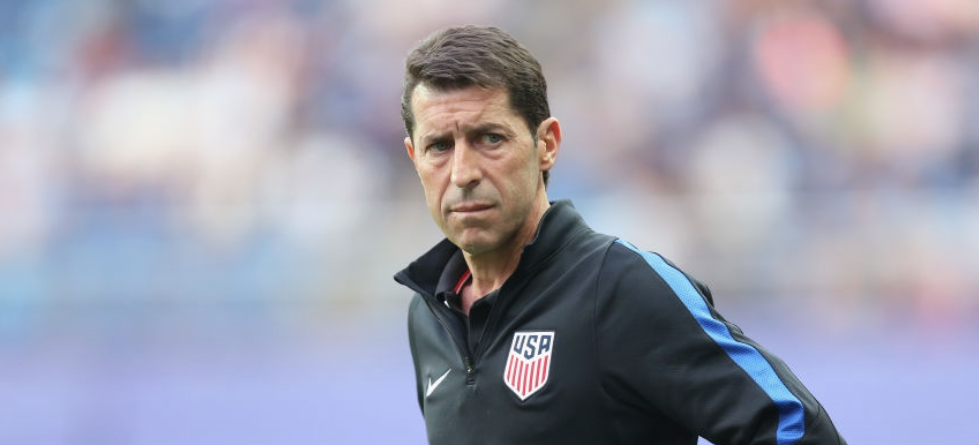While poised to fill the vacancy of U.S. Men’s National Team head coach if he is summoned in the future, Tab Ramos has a more immediate concern in his current position as Youth Technical Director of U.S. Soccer – improving the landscape for player development while elevating the status of the Youth National Teams.
“Thinking about the head job is not something I lose sleep over every day,” Ramos told SBI Soccer on SiriusXM FC’s The Coaching Academy. “I love the job that I have at U.S. Soccer. Historically, it’s the best year we’ve ever had with our youth national teams. Unfortunately, that gets overlooked because of the senior team at this point.
“None of us pictured ourselves being outside the World Cup,” said Ramos. “Especially in 2018.”
The Under-15 side advanced to its first CONCACAF final while the U-17’s reached the quarterfinal round of the World Cup. Under Ramos, the U-20’s won their first CONCACAF championship and advanced to the World Cup round of eight.
A streak of seven straight World Cups was halted, stimulating considerable conversation about player development in the states. Ramos indicated that specific enhancement schemes had already been studied – and implemented.
“I don’t think one result changes everything,” said Ramos. “These are the conversations we’ve been having for years.”
Beginning August 1, U.S. Soccer executed the Player Development Initiatives (PDI’s) which address the immediate and long-term growth of grassroots soccer targeting the 6-12 age group. Security on the ball resonated with the federation’s youth director.
“When I started in this position (2013) I wanted to address the fact that our players just lack a general comfort level on the ball,” said Ramos. “Although we want to compete against Brazil and the top nations in the world, it’s difficult. When you look at the players we normally choose from and you are to compare for example not an accomplished country like Guatemala or El Salvador, you see that their players are much more comfortable on the ball.
“At that point, we have an issue.”
To combat the technical deficiencies, Ramos suggested scenarios for the PDI that place our youngest players in conditions that require maximum touches on the ball.
“This year our kids are playing on smaller fields and in tighter spaces,” said Ramos. “Players around the world – I don’t want to say they’re lucky enough to be playing on playgrounds all the time. But it’s a fact our players don’t play that type of game. We can’t bring the playground to our players but we can try our best. By having smaller fields and more contact with the ball in traffic they have to react to different situations a lot more often than in the past. We’re hoping that down the road we start seeing the results.”
The initiative requires that U6-U8 play 4v4 without a goalkeeper; U9-U10 are 7v7 with a keeper; U11-U12 is 9v9 with a keeper. The U9-U12 implement a “build out line” which encourages the pre-teens to play through the keeper and back line.
“It’s going to be difficult to see until a few years from now when we have a generation of players that have gone though it,” said Ramos. “Small-sided games, having the players with an opportunity to play out of the back – it’s something that’s going to help us. We’re now playing the game and not just kicking the ball.”
College and High School Soccer
While NCAA Division 1 coaches lobby for a schedule that spans the full academic year, Ramos believes that the college game still plays a vital role in development.
“I think we’ve done enough of looking at college in a negative way and say it does not fit into our system and I happen to think the opposite of that,” said Ramos, a three-time All American at North Carolina State. “The best players in the country, particularly from midfield and the attacking side of the ball are signing professional contracts when they’re 15, 16, 17, 18. But there are a lot of defenders and a lot of players that are not physically ready to move into a professional environment who can still use the college game to develop.”
Ramos claims that U.S. Soccer is supporting upgrades that might expand the relationship between college and the national teams.
“One of the things that’s really important about the college game is that they have tremendous facilities,” said Ramos. “So I think its up to us to figure out how we can work together with the college programs to implement new programs to connect the college game a little bit better to the international game. I can tell you that’s something we are trying to work on every day.”
Ramos was the Parade Magazine Player of the Year at St. Benedicts Prep in 1983, the same high school attended by Claudia Reyna and Gregg Berhalter several years later. In a different era and with the birth of the U.S. Soccer Development Academy (USDA) in 2007, high school soccer is scarcely a factor in the development pyramid.
“I love the fact that high school games have that special rivalry between one town and another,” said Ramos who relished St. Benedict’s versus Scotch Plains in his scholastic days. “Although there are some excellent coaches, there are really very few good high school coaches in the country. There are very few programs that are running proper training sessions for their kids in high school. The high school game needs a lot of improvement in order to be part of the pyramid to grow into a professional soccer player.”
With rare exception, the USDA does not permit high school participation.

